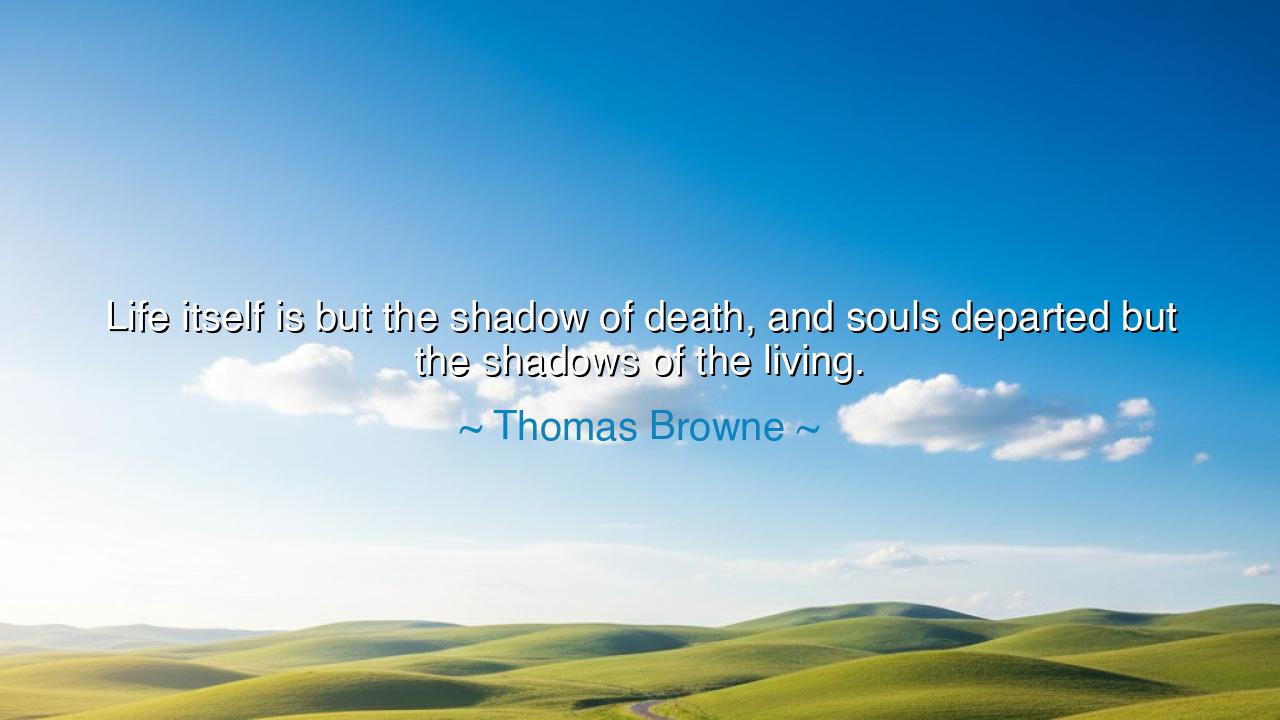
Life itself is but the shadow of death, and souls departed but
Life itself is but the shadow of death, and souls departed but the shadows of the living.






“Life itself is but the shadow of death, and souls departed but the shadows of the living.” So wrote Sir Thomas Browne, the 17th-century physician, philosopher, and mystic, whose mind wandered boldly through the mysteries of existence. His words are not meant to cast despair upon life, but to awaken us to its sacred transience. In this reflection, he speaks as one who has peered through the veil that divides being from non-being, who has seen that life and death are not opposites, but mirrors—one casting the other’s image upon the wall of eternity. Life, he tells us, is not the radiant substance we imagine, but a shadow, delicate and fleeting, moving between two realms: the seen and the unseen.
To Browne, death was not an end, but a continuation—the natural unfolding of a divine design. As a physician who tended both the living and the dying, he saw how fragile the boundary truly is. A heartbeat separates presence from absence, and yet, he understood, the essence of the soul does not perish. When he says that souls departed are but the shadows of the living, he means that the dead remain reflections of the vitality that once animated them—echoes of our own existence, still resonant in the world. The living and the dead, to Browne, are bound in a sacred continuity, each reflecting the other across the endless river of time.
This idea is as ancient as humankind itself. The philosophers of Greece, the sages of the East, and the poets of every age have spoken of life as a dream, a shadow, a passing illusion before the eternal dawn. Plato taught that the visible world is but a dim reflection of a higher, invisible reality. In his Phaedo, he described the body as a temporary dwelling, the soul’s shadowy garment. Browne, writing in the age of reason, took this mystical vision and clothed it in the language of faith and mortality. For him, the shadow of death was not something to fear, but a reminder that all things in life derive their meaning from their impermanence.
We may see this truth reflected in the story of Marcus Aurelius, the philosopher-emperor of Rome. Surrounded by wealth, power, and armies, he still meditated each night upon death. “You could leave life right now,” he wrote to himself. “Let that determine what you do and say and think.” In the shadow of that thought, he found peace. Like Browne, Aurelius understood that to live wisely is to live in the awareness of death—not as a morbid fixation, but as a source of clarity. When we remember that our days are shadows, we no longer waste them chasing illusions. We live more fully, more kindly, more humbly, knowing that even the mightiest empires fade as surely as footprints in the sand.
Life, then, is the dance of shadows under the sun of eternity. Each moment passes like a figure moving across the stage, bright for a time, then gone. Yet the dance is no less beautiful for its brevity. The shadow of death is what gives depth and meaning to our existence—it teaches us to cherish, to act, to love, to forgive. Without that shadow, life would be flat and hollow, stripped of urgency and tenderness. Browne’s insight is not one of despair, but of reverence. He calls us to honor the ephemeral nature of life, to live not in denial of death, but in harmony with it.
The souls departed, too, are not gone; they dwell in the unseen places of memory and spirit. When we speak their names, when we carry their lessons, when we live by the virtues they embodied, their shadows move beside us still. Every parent who raises a child with love, every student who carries forward a teacher’s wisdom, every heart that remembers the kindness of the dead—these are proofs that death’s shadow is not cold, but luminous. The departed are not lost; they have simply stepped into the deeper part of the mystery, while we still walk within its light.
So, my friends, what lesson shall we draw from Browne’s solemn vision? It is this: live with the awareness of death, but without the fear of it. Let the shadow of death remind you to live your brief days with purpose and grace. Do not flee from the passing of time, for it is the very breath that gives life its meaning. Love deeply, forgive quickly, speak truthfully, and leave behind deeds that cast gentle shadows long after you are gone. For when our own hour comes—and it will come—we shall see that death was not the end, but the completion of the circle, and that we ourselves were but shadows preparing to merge with the eternal light.
Thus, as Browne teaches, life and death are but reflections of one another, two halves of the same divine mystery. To know this is to be wise; to accept it is to be free. And in that freedom lies the quiet strength of the soul—the calm knowledge that even as our shadows fade, the light that cast them never dies.






AAdministratorAdministrator
Welcome, honored guests. Please leave a comment, we will respond soon